My thread titles just get worse and worse and worse. This is a step by step of a plastic pot belly. It has proven highly succesful in most of the rivers that I fish and has been a bit of a banker for me in the last 7 years for salmon. In the pattern I tried to take the 'standard potbelly' if such a thing still exists a stage further. The natural shrimp body has a carrot like shape and carries its black coloured eggs at its rear end in this case the front end of the fly. This pattern is a rather lurid orange colour hence the Carotene title.
Tying Materials
Tube: I have found that the Veniard Plastic 1/2in Slipstream Tube offers as good a starting point as any for the pattern.
Thread: Black.
Rostrum: A feather from an orange dyed salmon shrimp patch.
Feelers: Orange dyed boar bristles.
Body: Orange Extra Fine Straggle Ice.
Rib: Medium silver wire.
Hackle: A feather from a black dyed salmon shrimp patch.
Wing: A short bunch of dark orange dyed bucktail overlaid with a doubled and redoubled length of silver Krystalflash.
Cheeks: Medium sized jungle cock nails.
Tying Method
Step 1: Mount the tube on your choice of mandrel. I have used a felting needle. If you do the same then please take care as they are extremely sharp and they really hurt :. Attach black tying thread and wind.
Step 2: Tie in an orange dyed hackle from a salmon shrimp patch by the tip.
Step 3: Double the hackle and wind to form a rostrum.
Step 4: Tie in 3 orange dyed boar bristles.
Step 5: Tie in a length of medium silver wire.
Step 6: Tie in a length of orange extra fine Straggle Ice.
Step 7: Wind the thread over the root of the rostrum and over the base of the bristles this should build up a pronounced hump. Wind the tying thread to the front end of the tube. Wind the Straggle Ice for approximately 3 touching turns wind back toward the rear of the tube for 2 turns and then continue to wind towards the front end of the tube and tie off. This operation should provide you with the 'carrot profile'.
Step 8: Wind the silver wire in open turns to form rib.
Step 9: Tie in a feather from a black dyed salmon shrimp patch by the tip.
Step 10: Double the hackle and wind to form a collar. When wet the hackle will sweep into the body material providing representation of the shrimp eggs.
Step 11: Tie in short bunch of dark orange bucktail as a wing. The wing tips should terminate short of the boar bristles.
Step 12: Double and redouble a length of silver Krystalflash and overlay the bucktail wing.
Step 13: Tie in a pair of medium sized jungle cock nails at 45 degrees to each other over the wing.
Step 14: Whip finish and varnish to complete the fly.
Step 15: A view from the rear shows an aspect of the all important profile.
Step 16: If you have had the dubious pleasure of fishing with me or the even more dubious pleasure of using any of my patterns it is best you unclog the tube end of dried varnish ???
Tying Materials
Tube: I have found that the Veniard Plastic 1/2in Slipstream Tube offers as good a starting point as any for the pattern.
Thread: Black.
Rostrum: A feather from an orange dyed salmon shrimp patch.
Feelers: Orange dyed boar bristles.
Body: Orange Extra Fine Straggle Ice.
Rib: Medium silver wire.
Hackle: A feather from a black dyed salmon shrimp patch.
Wing: A short bunch of dark orange dyed bucktail overlaid with a doubled and redoubled length of silver Krystalflash.
Cheeks: Medium sized jungle cock nails.
Tying Method
Step 1: Mount the tube on your choice of mandrel. I have used a felting needle. If you do the same then please take care as they are extremely sharp and they really hurt :. Attach black tying thread and wind.
Step 2: Tie in an orange dyed hackle from a salmon shrimp patch by the tip.
Step 3: Double the hackle and wind to form a rostrum.
Step 4: Tie in 3 orange dyed boar bristles.
Step 5: Tie in a length of medium silver wire.
Step 6: Tie in a length of orange extra fine Straggle Ice.
Step 7: Wind the thread over the root of the rostrum and over the base of the bristles this should build up a pronounced hump. Wind the tying thread to the front end of the tube. Wind the Straggle Ice for approximately 3 touching turns wind back toward the rear of the tube for 2 turns and then continue to wind towards the front end of the tube and tie off. This operation should provide you with the 'carrot profile'.
Step 8: Wind the silver wire in open turns to form rib.
Step 9: Tie in a feather from a black dyed salmon shrimp patch by the tip.
Step 10: Double the hackle and wind to form a collar. When wet the hackle will sweep into the body material providing representation of the shrimp eggs.
Step 11: Tie in short bunch of dark orange bucktail as a wing. The wing tips should terminate short of the boar bristles.
Step 12: Double and redouble a length of silver Krystalflash and overlay the bucktail wing.
Step 13: Tie in a pair of medium sized jungle cock nails at 45 degrees to each other over the wing.
Step 14: Whip finish and varnish to complete the fly.
Step 15: A view from the rear shows an aspect of the all important profile.
Step 16: If you have had the dubious pleasure of fishing with me or the even more dubious pleasure of using any of my patterns it is best you unclog the tube end of dried varnish ???

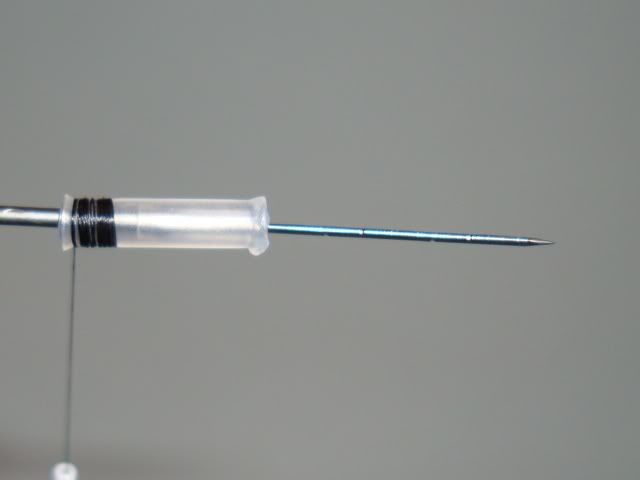

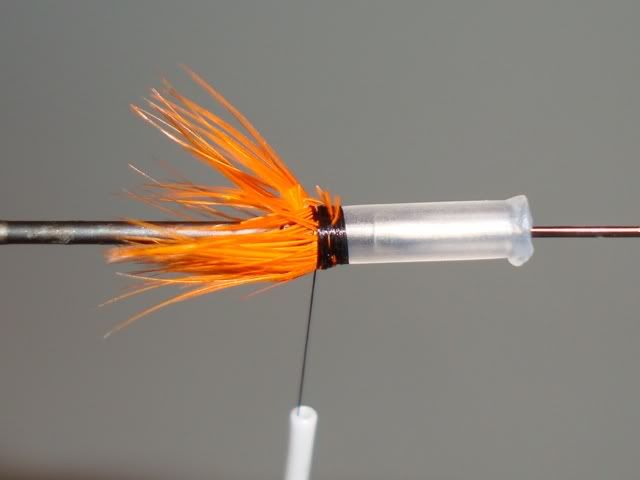

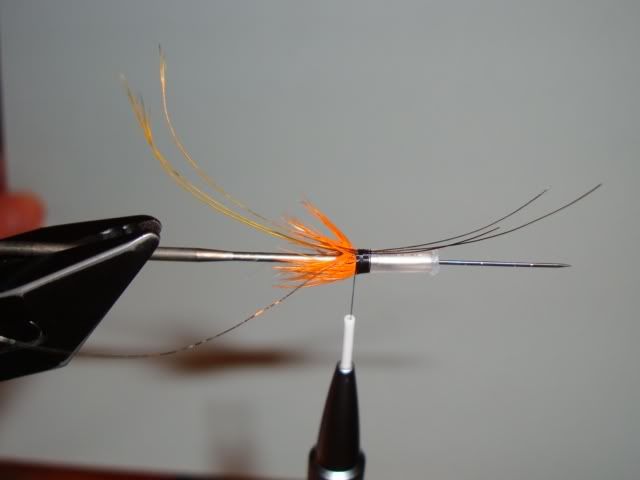
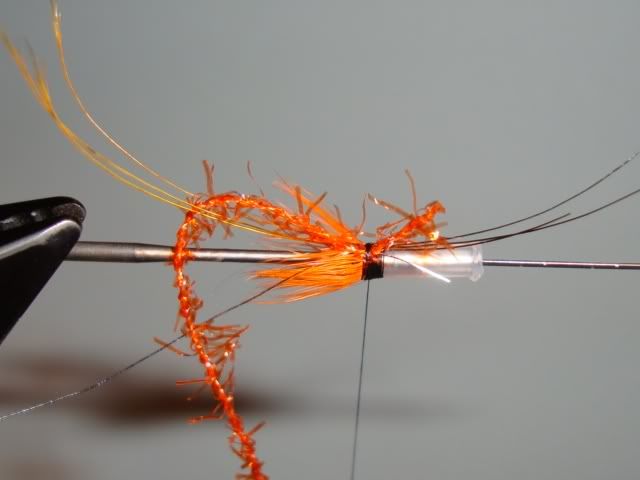
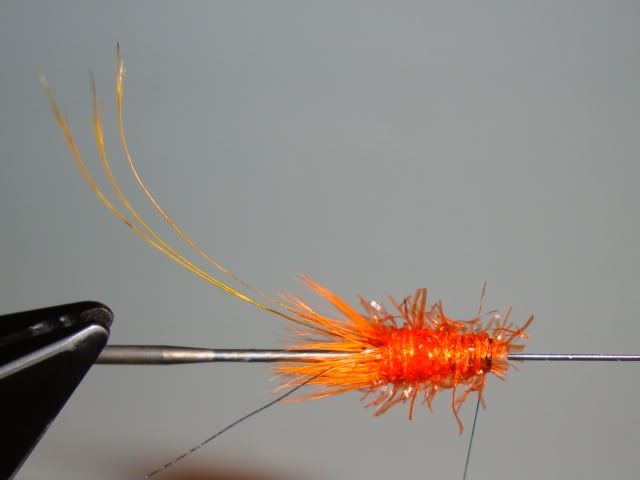
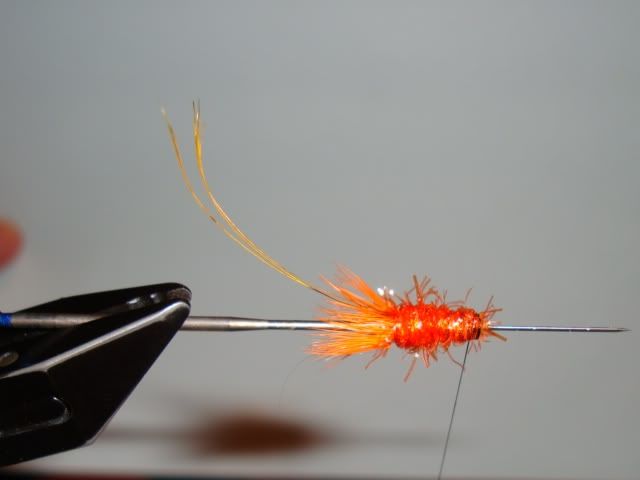


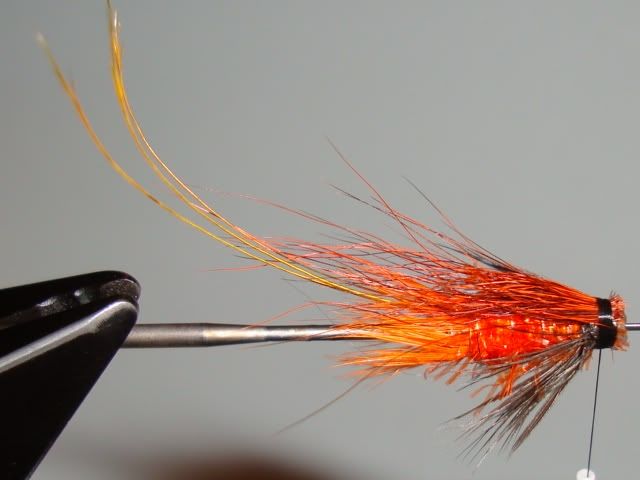
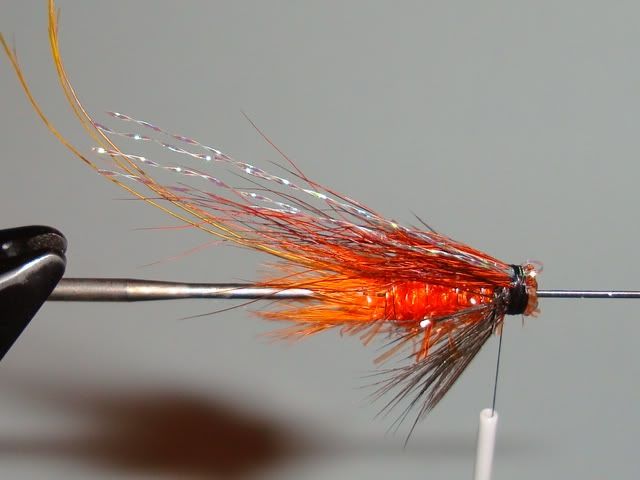
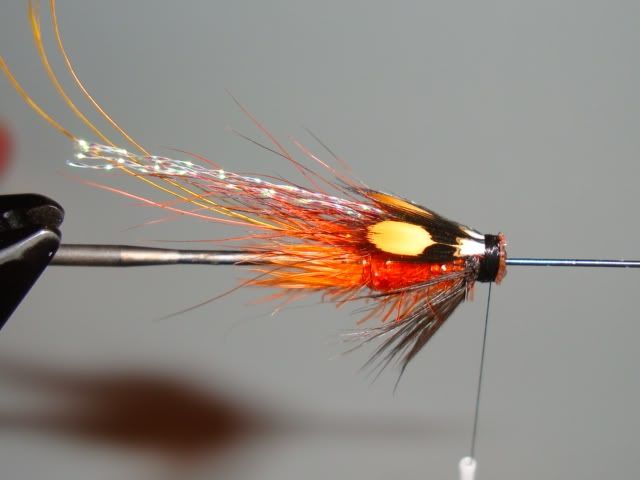
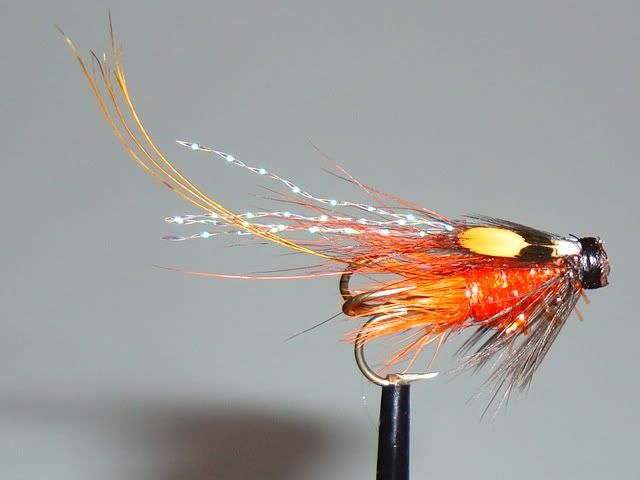

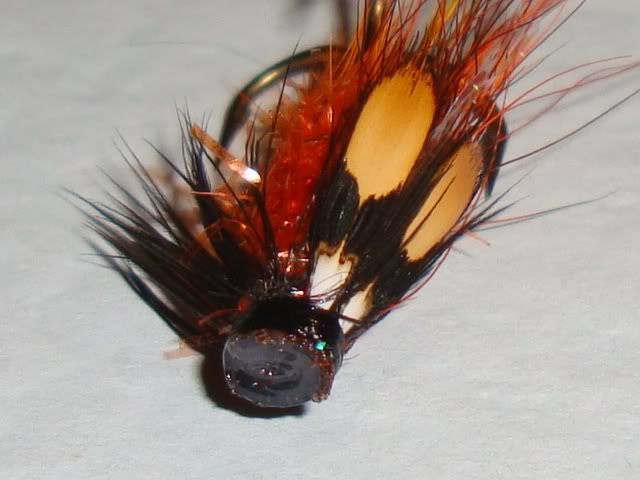
Comment